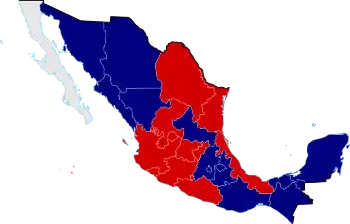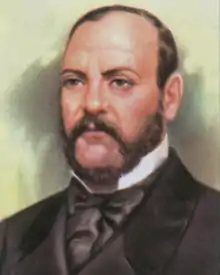Plan of Tacubaya
Plan of Tacubaya (Spanish: Plan de Tacubaya) was issued by conservative General Félix Zuloaga on 17 December 1857 in Tacubaya against the radical liberal Constitution of 1857 that among other provisions abolished special privileges (fueros) of the Catholic Church and the army. President Ignacio Comonfort, a moderate liberal, joined with Zuloaga, commander of the garrison in the capital, and closed congress, which had been elected under the new constitution. Comonfort failed to create a moderate regime and undermined his support with liberals with his repudiation of the new constitution and the congress. Zuloaga then repudiated Comonfort on 11 January 1858, which led to a three-year civil war between conservatives and liberals.[1][2]

Support the Plan of Tacubaya
No support for the Plan of Tacubaya
Neutral

Plan of Tacubaya, Tacubaya, Mexico City, Mexico.
Presidents of Mexico, recognized by conservatives 1857-1862
| President | Took office | Left office | Notes | |
|---|---|---|---|---|
 |
Ignacio Comonfort (1812–1863) |
December 17, 1857 | January 21, 1858 | After the declaration of Plan of Tacubaya, Congress declared that he was no longer president but he was recognized by conservatives as president with absolute powers.[3][4] |
.png.webp) |
Félix María Zuloaga (1813–1898) |
January 11, 1858 | December 24, 1858 | After repudiating Comonfort, Zuloaga was appointed president by the Conservative Party.[5] |
.png.webp) |
Manuel Robles Pezuela (1817–1862) |
December 24, 1858 | January 23, 1859 | He assumed the conservative presidency with the support of the Plan de Navidad.[6][7] |
.png.webp) |
Félix María Zuloaga (1813–1898) |
January 24, 1859 | February 1, 1859 | He was restored to the presidency by a counter-rebellion led by Miguel Miramón.[6][8] |
.png.webp) |
Miguel Miramón (1831–1867) |
February 2, 1859 | August 13, 1860 | He assumed the conservative presidency as a substitute when Zuloaga left office.[9] |
 |
José Ignacio Pavón (1791–1866) |
August 13, 1860 | August 15, 1860 | As president of the Supreme Court of the conservative government, he took office for two days when Miramón left office.[10] |
.png.webp) |
Miguel Miramón (1831–1867) |
August 15, 1860 | December 24, 1860 | He took office as interim president of the conservative government after he was elected by a group of "Representatives of the States" who supported the conservatives. He was defeated at the Battle of Calpulalpan, resigned the presidency and fled the country.[11] |
.png.webp) |
Félix María Zuloaga (1813–1898) |
May 23, 1860 | December 28, 1862 | Despite having been defeated, the conservatives appointed Zuloaga as president until December 28, when they recognized the Regency who was seeking to reestablish the Mexican Empire.[12] |
References
- Hamnett, Brian R. "Wars of Reform (Three Years War)" in Encyclopedia of Mexico, Chicago: Fitzroy Dearborn 1997, p. 1601.
- "Plan of Tacubaya, December 17, 1857, Historical Documents Digital Library Bicentennial, Federal Government" (PDF). Archived from the original (PDF) on October 26, 2011. Retrieved May 24, 2013.
- "Es proclamado el Plan de Tacubaya, con el que los conservadores pretenden derogar la Constitución de 1857". Memoria Politica de México. Archived from the original on March 4, 2016. Retrieved April 29, 2013.
- "El Congreso declara que dejó de ser Presidente de la República don Ignacio Comonfort desde el 17 de diciembre de 1857". 500 años de México en documentos. Retrieved April 29, 2013.
- "Tras desconocer a Comonfort, Félix María Zuloaga es nombrado presidente por el partido conservador". Memoria Politica de México. Archived from the original on November 1, 2012. Retrieved April 30, 2013.
- "Asume la presidencia del gobierno conservador el general Manuel Robles Pezuela". Memoria Politica de México. Archived from the original on November 1, 2012. Retrieved April 30, 2013.
- "Plan de Navidad". Memoria Politica de México. Retrieved April 30, 2013.
- "FÉLIX MARÍA ZULOAGA (1813-1898)". Bicentenario de México. Archived from the original on August 26, 2017. Retrieved April 30, 2013.
- "Zuloaga nombra presidente sustituto de la República a Miguel Miramón". Memoria Politica de México. Archived from the original on November 1, 2012. Retrieved April 30, 2013.
- "José Ignacio Pavón, presidente de la Suprema Corte, se encarga durante dos días del poder ejecutivo del gobierno conservador". Memoria Politica de México. Archived from the original on November 1, 2012. Retrieved April 30, 2013.
- "Toma posesión como presidente interino de la República, Miguel Miramón. Juárez sigue siendo el presidente legal". Memoria Politica de México. Archived from the original on November 1, 2012. Retrieved April 30, 2013.
- "Felix Maria Zuloaga". Chihuahua, México. Retrieved April 30, 2013.
This article is issued from Wikipedia. The text is licensed under Creative Commons - Attribution - Sharealike. Additional terms may apply for the media files.